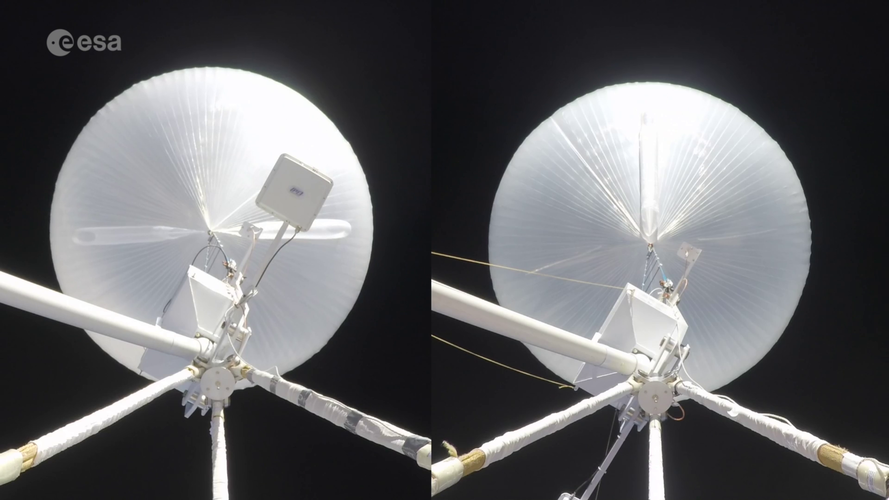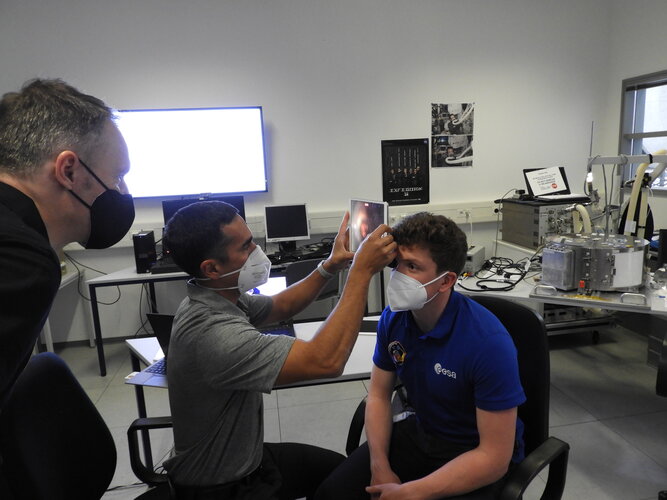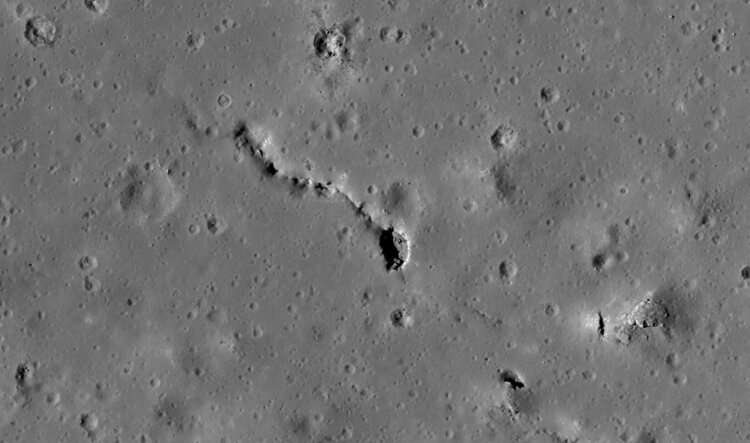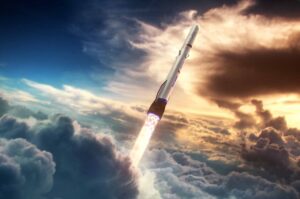Double drop test success for ExoMars parachutes
Tuesday, 14 December 2021 07:30
The largest parachute set to fly on Mars has completed its first successful high-altitude drop test, a critical milestone for ensuring the ExoMars mission is on track for launch in 2022. Both the first and second stage parachutes have now successfully flown this year.
Double drop test success
Tuesday, 14 December 2021 07:30 Video:
00:01:30
Video:
00:01:30
Onboard video footage from two high-altitude drop tests of the ExoMars second stage parachute. The cameras are on the drop test vehicle and capture the moment of separation from the stratospheric balloon, the release of the pilot chute, and the extraction of the main parachute.
The footage is shown at various speeds, capturing in slow motion the inflation of the 35 m wide subsonic parachute – the largest ever to fly on Mars.
The drop tests took place in Oregon on 21 November and 3 December as part of the ongoing parachute testing to ensure the safe delivery of
ESA Highlights: images and achievements from 2021
Tuesday, 14 December 2021 07:00
ESA Highlights: images and achievements from 2021
ESA Highlights 2021 is available online in this interactive format, which can be read on your desktop computer, laptop, tablet or phone.
Artificial intelligence for eye health in space
Tuesday, 14 December 2021 07:00
Young researchers from ESA’s Spaceship EAC initiative are keeping a good eye on ocular health by using images of astronauts’ optical discs in space to train an artificially intelligent (AI) model. All going well, this model will be used to automatically detect changes in the optic nerve of astronauts, known as Space-Associated Neuro-ocular Syndrome (SANS).
TEC Business to Business website
Tuesday, 14 December 2021 06:52
TEC Business to Business website
Satellite operators criticize “extreme” megaconstellation filings
Tuesday, 14 December 2021 04:26
Established satellite operators expressed their frustration at the wave of filings for enormous satellite constellations, arguing nations need to step forward and establish rules to curtail such systems.
BlackSky to begin transition to higher-resolution imaging satellites in 2023
Monday, 13 December 2021 21:00
With 12 satellites currently in orbit, BlackSky plans to add two or four more next year before it transitions to a higher-resolution spacecraft in 2023.
BlackSky to begin transition to higher-resolution imaging satellites in 2023
Monday, 13 December 2021 21:00
With 12 satellites currently in orbit, BlackSky plans to add two or four more next year before it transitions to a higher-resolution spacecraft in 2023.
Spelunking on the moon: New study explores lunar pits and caves
Monday, 13 December 2021 20:50
The moon may be a mostly uniform expanse of gray, but if you look closely, you can still find a few nooks and crannies in its surface, from deep trenches to pits and maybe even caves.
Now, researchers at CU Boulder have set out to explore what the environment might be like inside some of these shadowy features—many of which are too dark to see clearly from orbit.
The team's preliminary results suggest that pits and caves on the moon showcase remarkably stable conditions. They don't seem to experience the wild swings in temperature that are common at the moon's surface, said Andrew Wilcoski, a graduate student in the Department of Astrophysical and Planetary Sciences at CU Boulder. He will present the group's initial findings Friday at the American Geophysical Union fall meeting in New Orleans.
"If we're hoping to send people into these caves in the decades ahead, we want to know what they should expect down there," said Wilcoski, a co-author of the new research.
New launch vehicles face schedule pressure
Monday, 13 December 2021 18:02
Executives of two launch companies insisted their vehicles will be ready for their inaugural flights in 2022 while a third acknowledged their new vehicle’s first flight will likely slip beyond the end of next year.
Op-ed | What could happen to the LEO broadband constellations?
Monday, 13 December 2021 14:59LEO broadband constellations will greatly exceed their budgets. Still, because the titans of technology and institutions backing most of these systems have extremely deep pockets, we shouldn't expect any of these systems to disappear unless their backers decide to back out.
Interview: Japanese tourist says space trip 'amazing'
Monday, 13 December 2021 14:32
A Japanese space tourist on Monday rejected criticism from those who questioned his decision to pay a fortune for a trip to the International Space Station, saying the "amazing" experience was worth it.
South Korea, Australia sign MOU on space cooperation
Monday, 13 December 2021 13:50
South Korea and Australia agreed to work together to improve capacities in space situational awareness, Earth observation, space traffic and debris management.
Bundle up for the 2021 Geminid meteors
Monday, 13 December 2021 13:46
Ready to brave the cold? If you're like us, you haven't wasted an early clear sky morning to get out and see Comet C/2021 A1 Leonard before it heads southward. The coming days offer another early AM celestial sight: the Geminid meteors. To be sure, 2021 sees the Geminid meteors transpire under somewhat challenging conditions. But fear not: With a little planning and patience, you too can witness the "Tears of the Twins."
Circumstances for 2021: First, the bad news: the Geminids peak this year on Tuesday, December 14 at 7:00 Universal Time (UT) or ~2:00 AM EST, just over four days prior to full moon on the 19th. This puts the moon at 80 percent illumination waxing gibbous, meaning there's a narrow window of 'true darkness' between moonset and the beginning of dawn. For example, here in Norfolk, Virginia at latitude 37 degrees north, the moon sets at 2:53 AM EST on the 14th, and dawn begins at 5:37 AM EST just a few hours later.
Five weird things that happen in outer space
Monday, 13 December 2021 11:04
It doesn't take a rocket scientist to know space is weird. But just how weird might surprise you. Space is dominated by invisible electromagnetic forces that we typically don't feel. It's also full of bizarre types of matter that we never experience on Earth. Here's five unearthly things that happen almost exclusively in outer space.
1. Plasma
On Earth, matter typically assumes one of three states: solid, liquid, or gas. But in space, 99.9% of normal matter is in an entirely different form—plasma. Made of loose ions and electrons, this substance is in a supercharged state beyond gas that's created when matter is heated to extreme temperatures or is plied with a strong electric current.
Although we rarely interact with plasma, we see it all the time. All the stars in the night sky, including the sun, are mostly made of plasma. It even appears occasionally on Earth in the form of bolts of lightning and in neon signs.
In comparison to gas, where individual particles chaotically zoom about, plasma can act collectively, like a team. It both conducts electricity and is influenced by electromagnetic fields—which operate under the very same force that keeps magnets on your fridge.

